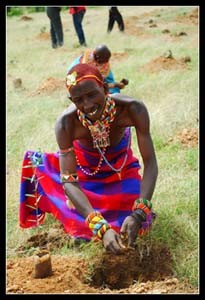Reforestation
Kenya’s indigenous forests have been depleted at an unprecedented rate over the past few decades to make poor quality charcoal and make way for inefficient agricultural land use. Only pockets of indigenous forests now survive. The Engelesha Cedar forest on the Southern end of the conservancy is one of these, home to melanistic leopards and colobus monkeys and several endangered and endemic species.
The Laikipia County Government aims to increase forested land in Laikpia by 20%, especially in important water catchment basins. Ol Ari Nyiro, and in particular the Engelesha forest, is acknowledged as an important water tower and the main source of water for lakes Baringo and Bogoria.
A simple but effective conservation practice, tree planting has long been part of GMF policy. In 2008 we planted one million trees in community villages and schools for the 1 billion Tree- Plant for the Planet Campaign. This year we aim to expand the Engelesha forest by planting over 5,000 trees: African Olive, Terminalia brownii, Acacia abyssinica, Erytrina abyssinica, Protea gaguerdii, and Red Cedar which, since they constitute the primary habitat for the endangered Colobus monkey population here in the 2000 acres of original, protected Engelesha Forest, are of particular importance.
Illegal exploitation and trade in flora, such as illegal logging, has been estimated to represent a value of USD 30-100 billion annually or 10-30 per cent of the total global timber trade.
You can sponsor the planting of an indigenous tree for as little as $10 a tree. Your $10 will cover:
– land preparation
– planting
– protection from nibbling animals
– watering
– and tending for the first 2 years after which it will become self sufficient.
Each tree will be tended to by a member of the local community and will return substantial benefits to the community – not only through employment and out-growers schemes but also through the sustainable wild harvest of indigenous forest product. When mature the expanded forest will also serve as a secondary barrier between the farming community in the south and potentially crop raiding animals.
Donate Now


